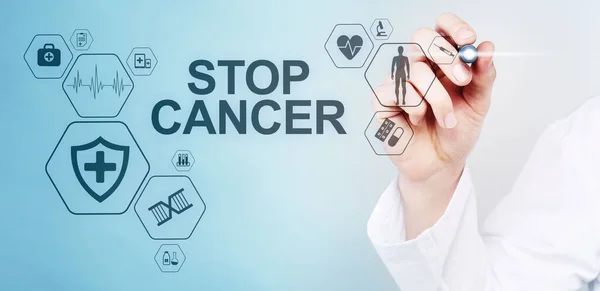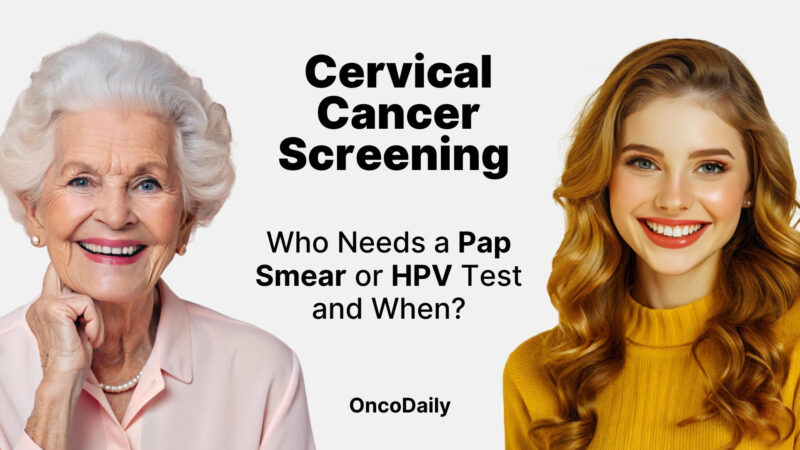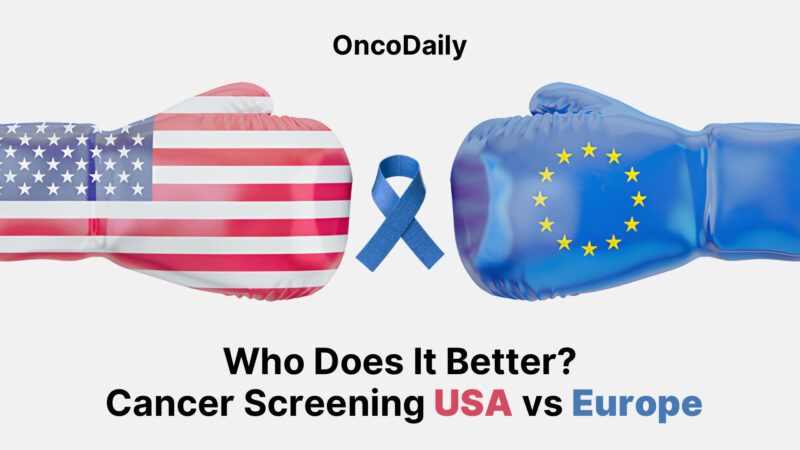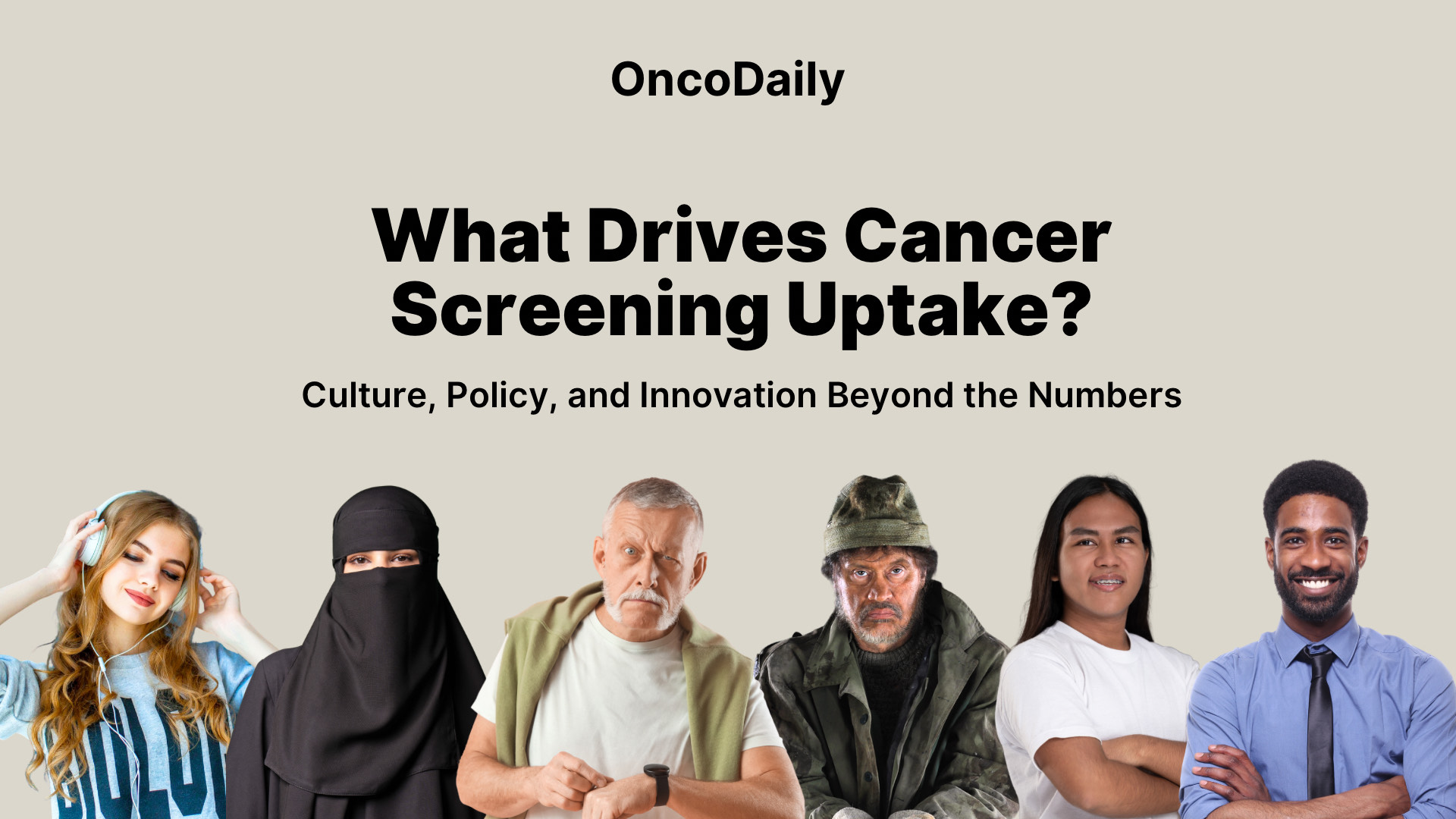“Everyone who is born holds dual citizenship in the kingdom of the well and in the kingdom of the sick”
Susan Sontag, Illness as Metaphor 1978
Cancer screening saves lives. According to the National Institute of Health, between 30% and 50% of cancer deaths could be prevented through a combination of risk factor avoidance and effective screening. Nearly 6 million deaths from five major cancers (breast, cervical, colorectal, lung and prostate) were averted in the U.S. between 1975 and 2020, and nearly 80% of those lives were saved through screening intervention rather than treatment alone.

Screening has had an outsized impact on colorectal cancer deaths, which were reduced by 79% via screening and removal of precancerous polyps, and prostate cancer deaths by 56% through PSA screening. Cervical cancer deaths were almost entirely prevented by Pap smears and HPV testing combined with the removal of precancerous lesions. National Institute of Health, NIH website, 2025.
Screening is not just a tool for cancer detection – it’s a way to identify early warning signs before symptoms appear, making it possible to treat or even prevent invasive disease. The goal of screening goes beyond early detection. When combined with follow-up diagnostics, individualized care strategies, and timely medical response, screening can reduce both mortality and the development of more advanced cancers, thus lowering the overall burden of cancer (Y Shieh, Nat Rev Clin Oncol, 2019).
The success of cancer screening is not determined by medical tools alone: it is deeply influenced by cultural metaphors, societal norms, and policy frameworks. These factors often play a central role in guiding screening behavior and ultimately answer the question of “What Drives Screening Uptake.” They are fundamental to both the uptake and the effectiveness of screening, shaping the environment in which people make decisions and where care is accessed and delivered.
This article explores how culture, society, policy and innovation influence cancer screening behavior. Starting with the role of trust and beliefs within communities, and continuing through the impact of structured policy initiatives and the impact of innovation, we’ll look at how people’s surroundings shape their choices—and how thoughtful implementation can help close the gap between what screening can do and what it achieves.
Why Do Some Cultures Avoid Screening?
“Nothing is more punitive than to give a disease a meaning – that meaning being invariably a moralistic one”, Susan Sontag writes in Illness as Metaphor (1978). The way we talk about illness often shapes how we understand and respond to it. Metaphors can stigmatize, moralize, or mystify disease. These symbolic meanings are deeply rooted in cultural beliefs, values, and narratives. Understanding cancer screening behavior, then, requires looking beyond individual decision-making to the cultural context that informs how illness is perceived and acted upon.
Beliefs about cancer are often shaped by how it’s understood in relation to the divine. In some communities, cancer is seen not just as an illness, but as a punishment, a test of faith, or the result of supernatural forces such as the evil eye or black magic. Besides creating stigma, these interpretations can foster religious fatalism – the belief that health outcomes are predetermined and ultimately beyond human control.
When people hold this view, they may turn to prayer or traditional healing instead of screening or treatment, trusting that recovery, if it comes, will come from divine intervention. This can discourage timely screening and medical care, particularly when layered with feelings of guilt or fear of moral judgment. P Hellyer, Br Dent J, 2002. D L Swihart, StatPearls, 2023.
Modesty and gender norms play a significant role in shaping cancer screening behaviors, perception of medical care, and attitudes toward healthcare providers. In many conservative cultural communities, modesty concerns – particularly around exposing the body during clinical exams – are a major barrier to cancer screening. The presence of male healthcare providers often heightens this discomfort for women, leading to delayed or avoided screenings.
Gender norms may also limit women’s autonomy, with health decisions influenced by husbands or male family members, and a tendency to prioritize family over personal health. These factors shape preferences for female providers and contribute to mistrust or discomfort in clinical settings that don’t accommodate cultural expectations. Screenings may be seen as intrusive or shameful, reinforcing fear or embarrassment. S F Moey, Asian Pac J Cancer Prev, 2022. C S Ferreira, Mol Clin Oncol, 2021.
Do We Take Some Cancers More Seriously Than Others — and Why?
Cancer doesn’t only confront the body – it confronts what a body means within a culture. The cultural meanings we assign to different parts of the body can profoundly shape how individuals respond to cancer diagnoses and screening. As Sontag writes in “Illness as Metaphor” ,
“cancer is notorious for attacking parts of the body … that are embarrassing to acknowledge,”
noting that some cancers carry more social shame than others. This “hierarchy” of body parts affects not only how people feel about a diagnosis, but whether they seek screening at all.
In the case of breast cancer, in Ghana, it’s often viewed through a spiritual or moral lens, leading to delayed diagnosis and treatment. Among Muslim women in Gulf and Middle Eastern countries, as well as in immigrant communities in the West, cultural attitudes around modesty, privacy, and fatalism often contribute to lower screening rates. These aren’t just personal choices: they reflect how illness is interpreted in context. O Ayaad, Asian Pac J Cancer Biol, 2025. A Afaya, BMC Womens Health, 2024.
Cervical cancer is similarly affected by stigma, particularly in Hispanic, Asian Indian, and Mexican immigrant groups, where cultural and religious norms around sexual purity discourage Pap smears and delay care. J S Luque, J Immigr Minor Health, 2015. R Jillapalli, Med Res Arch, 2022.
Colorectal cancer sits somewhere in the middle of this hierarchy, often avoided not only because of embarrassment but also due to fatalistic beliefs. In some U.S. communities, the idea that colorectal cancer is inevitable or not preventable discourages screening altogether. Interestingly, that same fatalism can increase screening rates for breast cancer in other communities—reminding us that beliefs are not formed in isolation: they are shaped by geography, history, religion, and lived experience. T M Layne, Front Oncol, 2023.
The Influence of Community and Social Norms on Screening Behavior
Societal and family dynamics can negatively impact cancer screening rates in ways that reflect both social attitudes and practical limitations. A lack of family support or negative attitudes toward illness and healthcare can discourage screening. When cancer is seen as something shameful, spiritually charged, or better left unspoken, screening is often resisted. Women, in particular, may delay care if health is consistently deprioritized in favor of family responsibilities, or if they’re simply not encouraged by those around them. The absence of family history also can contribute to a false sense of safety and lower the likelihood of getting screened. L Ponce-Chazarri, Cancers (Basel), 2023. S Gupta, Asian Pac J Cancer Prev, 2025.
Fear of social judgement or being labeled as ill can silence conversations and reduce support for preventive care. As Sontag notes, cancer has long been linked to ideas of repression and personality flaws – creating the notion of “cancer personality” marked by negativity or passivity. These associations not only stigmatize the disease but also discourage open dialogue and early action.
Social stigma can deepen these challenges. In many communities, seeking screening – particularly for cancers associated with private or socially sensitive body parts – is often seen as unnecessary or even questionable. S Gupta, Asian Pac J Cancer Prev, 2025.
Misinformation and mistrust of medical systems – sometimes rooted in past negative experiences – can also circulate within families and communities. When trusted sources spread skepticism or fear about screening, it can undermine trust in healthcare providers and discourage participation. Similarly, the absence of trusted community leaders or health workers promoting screening can leave a gap in both knowledge and confidence. L Ponce-Chazarri, Cancers (Basel), 2023.
Finally, economic barriers – low income, lack of insurance, and competing family demands – often make screening difficult to access. These challenges are intensified in households where family members – especially women – are expected to prioritize others’ needs over their own health. L Ponce-Chazarri, Cancers (Basel), 2023.
Fear, Shame, or Denial: What’s Really Stopping You from Screening?
“Cancer patients don’t look at their biopsies”, Sontag writes, and this captures the deep fear and denial that often surround the disease. For many, cancer is terrifying to even think about – let alone getting screened: what if the tests reveal something concerning? As Sontag puts it, cancer is sometimes “identified with death itself”, and so a screening test isn’t just a routine check anymore – it becomes a confrontation with mortality. The possibility of a positive result alone can provoke intense anxiety and avoidance. “… ‘why me?’ (meaning ‘it’s not fair’) is the question of many who learn they have cancer”.
In this emotional context, even considering preventive screening can feel psychologically threatening, making delay or avoidance a common response – despite the potential consequences of inaction.
People often fear the pain or discomfort associated with screening tests like mammograms or biopsies. Embarrassment is another common deterrent, especially when procedures involve bodily exposure. I Higgins, Psychooncology, 2025.
Anxiety is another significant barrier. Uncertainty about what the screening involves or what the results will reveal can cause ongoing mental distress. Even those who complete the screening often face heightened anxiety waiting for results or dealing with the consequences of a potential diagnosis. This psychological strain can prevent both initial participation and regular follow-up. L Carter-Harris, Thorax, 2020.
Past negative healthcare experiences can significantly hinder cancer screening and treatment. Encounters involving misdiagnosis, provider dismissal, or perceived discrimination often lead to lasting mistrust. In the U.S., this is particularly common among Black and low-income communities, where experiences of racism in the healthcare system contribute to lower screening rates and hesitancy to seek care. J Richmond, Cancer Epidemiol Biomarkers Prev, 2023.
These emotional barriers are often intensified by limited understanding of cancer risks and screening benefits, as well as distrust in the healthcare system.
How Do National Health Policies Encourage Early Detection?
Policy generally increases cancer screening rates by improving access to care, reducing financial barriers, and promoting participation through organized national or regional screening programs.
Making cancer screening free through insurance – with no copays or deductibles – has been shown to raise screening rates. Mandates for tests like mammography and colorectal screening may remove financial barriers, making it easier to get screened. Expanding insurance coverage, like through Medicaid in the U.S., also helps by making preventive care even more accessible. G Zhao, Am J Prev Med, 2024. A M Fendrick, Cancer Res Commun, 2023. C D Taylor, JAMA Health Forum, 2024.
Public awareness campaigns support these policies by helping people understand why screening matters. They address fear, misinformation, and lack of knowledge. They educate people about the benefits of early detection and encourage them to take action. Campaigns targeting underserved communities are especially effective in boosting participation. M Puckett, J Womens Health (Larchmt), 2019. A Martini, Patient Educ Couns, 2016.
Access to a regular primary care provider also makes a big difference. Regular visits with a doctor increase the chances of receiving screening recommendations. Policies that support primary care access and encourage providers to talk about screening improve overall rates. When combined with insurance coverage, the impact is even greater. J Hostetter, BMC Fam Pract, 2020. Ethan Gen Intern Med, 2016.
Organized, equitable screening programs can make the difference between early intervention and missed opportunity. Including invitations and consistent follow-ups, they lead to higher screening rates than one-off and opportunistic testing. Countries with these systems – especially in the EU – have seen colorectal screening rates reach as high as 72%. These programs also monitor performance to improve results. J Paulauskiene, Medicina (Kaaunas), 2019. Eurostat website, Cancer Screening Statistics, 2024.
Living guidelines offer a flexible approach to cancer screening recommendations. They’re continuously reviewed and adjusted based on the latest research and expert input, helping ensure screening practices stay up to date. This supports more personalized and timely strategies for cancer prevention and early detection. ESMO, ESMO website, 2025.
Effective screening policies help reduce cancer deaths by supporting early detection and timely treatment. But even with progress, screening rates are too low in many areas: gaps in policy can hold efforts back.
You Can Also Read Cervical Cancer Screening: Who Needs a Pap Smear or HPV Test and When? by OncoDaily

Where Are Our Screening Policies Falling Short?
Good policy can open doors, but it doesn’t always bring people through them: progress is real, but it’s not evenly felt. Screening programs often reach the well-informed and well-connected first, while others wait, unnoticed. Invitations may go unanswered, follow-up procedures may be incomplete, and the assumptions underlying policy design do not always align with the lived experiences of the target populations.
Across the EU, participation remains uneven. In some countries, fewer than half of eligible women undergo routine mammography. Eurostat, Breast Cancer Screening Rates Across the EU, 2023. J Vinegar, Sci Rep, 2024.
In the U.S., rural communities often have limited access to endoscopy centers: individuals in rural areas are 14% less likely to receive mammograms and 18% less likely to receive colonoscopies compared to those in urban areas.
Limited awareness and education about the importance of early cancer detection especially in rural areas pose a significant challenge, as many rural residents may not pursue timely screenings or fully understand the value of preventive healthcare.
People with lower incomes or without health insurance are less likely to access cancer screenings due to cost and limited healthcare access. Uninsured rates are higher in rural areas—9.1% compared to 7.3% in urban areas—making it harder for these individuals to afford medical care. Financial strain and lack of transportation further reduce the likelihood of seeking preventive services. S Kale, Cureus, 2023.
Timely follow-up after abnormal screening results is often missing – 51% of patients with abnormal breast, cervical, or colorectal cancer screening results did not complete recommended follow-up. J Martinez-Gutierrez, BMC Cancer, 2023.
Limited identification of high-risk individuals, such as those with a personal or family history of cancer, results in many not being recognized or offered the more intensive screening they may need: a study examining colorectal cancer cases in individuals aged 40 to 49 found that 1 in 4 met the criteria for early screening based on family history, and almost all of these patients could have been diagnosed or possibly even prevented from cancer if earlier screening had been implemented according to existing family history-based guidelines. S Gupta, Cancer, 2021.
How Is Technology Changing Cancer Prevention?
Innovation can increase cancer screening rates by introducing advanced and patient-friendly methods that overcome existing barriers. Advances in imaging technology and AI-driven tools have significantly improved the accuracy of cancer detection. By reducing false positives and false negatives, these technologies increase diagnostic confidence for both patients and providers. The use of AI tools in breast cancer detection can also help reduce the rate of interval cancers – those diagnosed between regular screening exams often because they were missed or not visible in the last mammogram. L T Thong, Lung Cancer, 2023. E A Abeelh, Cureus, 2025. K Lång, Eur Radiol, 2021.
Non-invasive screening options—such as liquid biopsies, capsule endoscopy, and molecular biomarker tests—along with AI-enhanced image analysis, make the process less intimidating and more affordable. These innovations lower logistical and psychological barriers, making it easier for more people to engage in preventive care. N Chacko, Clin Exp Med, 2024.
The impact of innovation goes beyond individual patients. Early detection through improved screening leads to better health outcomes and major cost savings. In the U.S., it’s estimated that early detection could save up to $6.5 trillion over the next 25 years. M Fendrick, Institute for Healthcare Policy and Innovation, 2023.
Together, these advances are increasing screening uptake, reducing disparities, and moving early detection into more routine, less invasive care. But to fully realize their potential, we must also address ongoing gaps that limit their widespread impact – gaps in access, implementation, data systems, and public trust. New technologies often remain out of reach for people who need them most. Still, every breakthrough creates new opportunities. And while innovation matters, it’s how we use it that shapes its impact. Technology alone won’t close screening gaps unless it’s paired with thoughtful implementation, attention to equity, and systems that make sure no one is left behind.
You Can Also Read USA vs Europe: Who Does Cancer Screening Better? by OncoDaily

How Can We Close the Screening Gap Effectively?
“And it is diseases thought to be multi-determined (that is, mysterious) that have the wildest possibilities as metaphors for what is felt to be socially or morally wrong.” – Sontag writes in Illness as Metaphor. “As long as a particular disease is treated as an evil, invincible predator, not just a disease, most people with cancer will indeed be demoralized by learning what disease they have.” To move forward, we must address not only practical barriers but also the invisible ones—those rooted in narrative, belief, and meaning. To help with cancer prevention efforts, we must first try to “de-mythisize it”. And the human factor in the process is far more influential than we often realize.
Health literacy gives the opportunity to make informed decisions. Higher health literacy is associated with better knowledge of cancer screening, more positive attitudes toward it, and greater intention to participate. Efforts to improve health literacy include simplifying health messages using plain language and visual aids, employing teach-back methods where patients repeat information to ensure understanding, tailoring educational materials to address specific cultural or language needs, and teaching through community programs and peer education. Healthcare providers play an important role in achieving this goal: clear, supportive communication can help overcome barriers more effectively than text-based information alone. V Baccolini, Prev Med, 2022. C Stormacq, JBI Evid Synth, 2020.
Peer behavior is also important in shaping individuals’ screening decisions. Women are more likely to participate in breast cancer screening if their peers have scheduled appointments shortly before their own. There is also research linking marital status to colorectal cancer screening rates: married individuals are more likely to participate. And if we rule out the possibility that health-conscious people are simply more likely to marry, this becomes an example of how seeing someone close to you – a peer you trust – take action can directly influence your behavior.
This effect is further strengthened when we consider the practical support that often comes with close relationships, such as shared transportation, joint insurance, scheduling and reminders. And, of course, having a trusted person within family or friends provides invaluable emotional support. People with strong social networks are more likely to adhere to screening because they receive encouragement, reassurance, and help managing the anxiety or fear that often comes with tests or results. This social support also improves mental well-being, reducing the distress that might otherwise keep people from participating. P Redler, SSRN Scholarly Paper, 2024. C H van Jaarsveld, J Med Screen, 2006. B K Datta, J Cancer Policy, 2024.
To make people feel safe about making the decision of getting screened we need to meet people where they are – not only geographically, but culturally and emotionally. A powerful example of this approach comes from a study in Peru, where training local women as health promoters led to a significant increase in cervical screening rates. These women received instruction on raising awareness about cervical cancer, implementing HPV self-sampling, and educating their peers on how to use the kits effectively. They conducted door-to-door outreach raising awareness, distributed self-sampling kits, and actively supported women who tested positive for HPV, sometimes accompanying them to the clinic to ensure they received follow-up care.
Community health leaders registered around 320 women (175 in rural areas and 145 in the city) in local venues, achieving 100% participation in HPV self-sampling and providing treatment to 81% of those who tested positive. This success was due to the trusted role of local women delivering culturally sensitive education and offering screening in familiar community spaces. Such interventions help overcome barriers related to lack of knowledge, cultural barriers, and limited access to care. C E Abuelo, J Community Health, 2014. M B Shin, Front Public Health, 2022.
Policy that works is policy that responds to people’s needs. Thailand’s national cervical screening program – reaching 80% of eligible women – is a clear example of what thoughtful, well-designed policy can achieve. It succeeded because it was built around how people actually live. Screening is delivered through primary care, including community health centers and mobile units, making services accessible even in remote areas. Village health volunteers – trusted members of the community – play a central role in reaching women, building awareness, and encouraging participation.
Thailand’s decentralized primary healthcare system enabled broad screening coverage across both urban and rural populations. This example underlines the importance of aligning policy with practical delivery mechanisms to ensure health services reach those who need them most. P Ploysawang, Asian Pac J Cancer Prev, 2021.
When it comes to technology in cancer screening, the most effective tools are those that bridge gaps, not widen them. Sometimes, the smartest tools are also the simplest. In Malaysia, for example, educational interventions delivered via WhatsApp messages have shown to enhance knowledge, perception, and motivation among women regarding the importance of cervical cancer screening. These groups also act as gentle reminders for scheduling and attending screening appointments. Similarly, personalized reminders through phone calls and text messages have improved adherence to follow-up appointments, strengthening continuity in cervical cancer screening. Z Mohhamad, JMIR Mhealth Uhealth, 2022.
Ideally, culture builds trust, policy ensures access, innovation lowers friction. Culturally adapted tools make health information more relatable and close to people. Supportive policies rooted in cultural understanding and local trust amplify impact and extend reach. Technology doesn’t need to be complex to work – it just needs to be accessible. When they align, meaningful change happens. And the alignment isn’t just strategic – it’s human-centered healthcare in action.
So, What Can You Do for Cancer Prevention?
Cancer prevention goes beyond medical breakthrough – it’s also about the daily actions we make: staying informed, supporting awareness, challenging myths, and making better choices when we can. Just as important is being able to talk about it – openly, honestly, and without judgement. Sometimes that means letting someone voice their fears. Other times, it’s as simple as reminding a friend about their appointment or encouraging a loved one to get screened. The responsibility may feel large, but meaningful change often begins with small decisions made by individuals.
Written by Seda Adibekyan, MDc.
